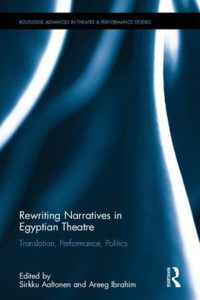Rewriting Narratives in Egyptian Theatre
 Translation, Performance, Politics
Translation, Performance, Politics
Edited by Sirkku Aaltonen and Areeg Ibrahim
2016 – Routledge, 288 pages
Hardback. ISBN: 978-1-13-894644-6, £85
This study of Egyptian theatre and its narrative construction explores the ways representations of Egypt are created of and within theatrical means, from the 19th century to the present day. Essays address the narratives that structure theatrical, textual, and performative representations and the ways the rewriting process has varied in different contexts and at different times. Drawing on concepts from Theatre and Performance Studies, Translation Studies, Cultural Studies, Postcolonial Studies, and Diaspora Studies, scholars and practitioners from Egypt and the West enter into dialogue with one another, expanding understanding of the different fields. The articles focus on the ways theatre texts and performances change (are rewritten) when crossing borders between different worlds. The concept of rewriting is seen to include translation, transformation, and reconstruction, and the different borders may be cultural and national, between languages and dramaturgies, or borders that are present in people’s everyday lives. Essays consider how rewritings and performances cross borders from one culture, nation, country, and language to another. They also study the process of rewriting, the resulting representations of foreign plays on stage, and representations of the Egyptian revolution on stage and in Tahrir Square. This assessment of the relationship between theatre practices, exchanges, and rewritings in Egyptian theatre brings vital coverage to an undervisited area and will be of interest to developments in theatre translation and beyond.
Table of Contents
Introduction Areeg Ibrahim and Sirkku Aaltonen
Part I. Intercultural Rewriting
1. Perspiring Translators, Rowdy Audiences and Ignorant Women: Narratives of the History of Egyptian Theatre Sirkku Aaltonen
2. Politics of Choice and Cultural Representation in Translating Egyptian Drama Between Two Revolutions (1952-2011) Areeg Ibrahim
3. Tawfiq al-Hakim as the Representative Egyptian Dramatist in the West Marvin Carlson
4. Performing and Rewriting Solitaire between Languages and Cultures: A Practitioner’s Testimonial Dalia Basiouny
Part II. Interlingual Rewriting
5. Allusion in Three Translations of Hamlet into Arabic Omaya Khalifa
6. Translation and Dramaturgy in Egyptian Performances of King Lear Mohamed Samir Al-Khatib (translated from Arabic by Mona Khattab)
7. On Translating Shakespeare into Arabic: A Translator’s Testimonial Mohamed Enani
Part III. Intertextual Rewriting
8. Theatre-making and Theatre Translation in Turn-of-the-century Egypt: Theatricalizing the Theatre Field in Muhammad Taymur’s The Trial of the Playwrights Sameh Hanna
9. From Spectators to “Spect-Actors.” All Tahrir’s a Stage Heba El-Abbadi & Sally Hammouda
10. Egyptian Realities on Stage and in Society Nehad Selaiha
Part IV.Intermedial Rewriting
11. DramatizingShort Stories. Yussef El Guindi’s Rewriting of Salwa Bakr’s “That Beautiful Undiscovered Voice,” and “Thirty-one Beautiful Green Trees” Salwa Rashad Amin
12. It is not Just Phonetics and Aristocrats, it is Sexuality and Politics. The Adaptation of Bernard Shaw’s Pygmalion in the Egyptian Theatre Wessam Elmeligi
13. A Documentary in the Making. Live on Stage: A Century and a Half of Theatre in Egypt Mona Mikhail
Afterword